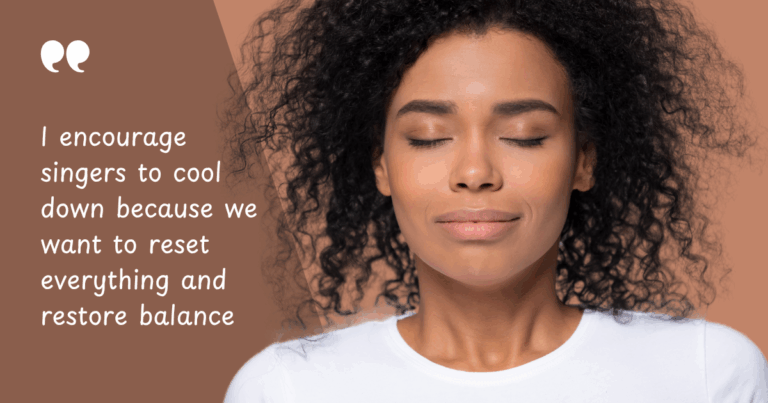A vocal cool down is the ideal way to wrap up after a big performance and help protect your voice for future gigs. Read on to discover why.
Basketball legend LeBron James has one, as does tennis legend Novak Djokovic.
We’re not talking about a cabinet full of trophies (although no doubt they both have plenty of silverware), but a cool down routine.
Many top athletes take time after a big match to help their aching bodies recover from intense physical exertion.
They might stretch, have a massage or even plunge into an ice bath.
The aim is to reduce inflammation and the chance of injury, and aid recovery.
A cool down can also be a useful way to quieten the mind and help shift to a calmer mental state after performing in front of thousands of people.
Vocal cool downs for singers
Vocal coach Line Hilton believes singers, who, after all, are vocal athletes, should also cool down after a big performance.
She’s not suggesting vocalists go to the same extremes as NBA and Wimbledon stars.
But taking a few minutes after a gig to cool down can be beneficial.
As Line says on the Singing Teachers Talk podcast: “I encourage singers to cool down because we want to reset everything and restore balance.
“If you’ve been performing for a few hours, maybe talking, maybe stressing about the performance, then you want to get rid of that tension.
“Or maybe you’ve been singing very belty songs and your voice has naturally been more tense and stressed. You don’t want to go to sleep on that tension.”
What does a vocal cool down entail?
As with vocal warm ups (which Line also discusses on the podcast), there’s no hard and fast rule with cool downs. It’s important that every singer gets to know their voice and devises a routine that works for them.
“But we probably won’t spend as much time on cooling down as we might on warming up,” Line says.
“It’s just maybe two or three minutes of exercises similar to the ones you might use for warming up.”
Line suggests lip trills, tongue trills and straw exercises can be helpful.
“Instead of thinking about winding up, we’re winding down,” she says. “So maybe you start with top-down exercises, getting into the revs and staying there and not really doing much in the way of wide-range glides.”
Another exercise Line recommends is the reverse fry, which is used by speech and language therapists.
“With the reverse fry you’re sucking in the air over semi-closed vocal folds,” Line says.
“You’re basically sucking the air over the vocal folds rather than pushing the air out.
“It’s a good way to relax the intrinsic muscles and reset the vocal folds.”
Vocalists can also use their cool down to reflect on their performance. It’s an opportunity to weigh up what went well in the gig and identify areas to work on.
“It’s useful to set a goal for next time, so that you can continue to improve,” Line says.
Learn more
Is your pre-performance and post-performance routine up to scratch? Listen to Line’s warm up and cooldown suggestions on the podcast to see if you can improve what you do.
Main image: Canva




